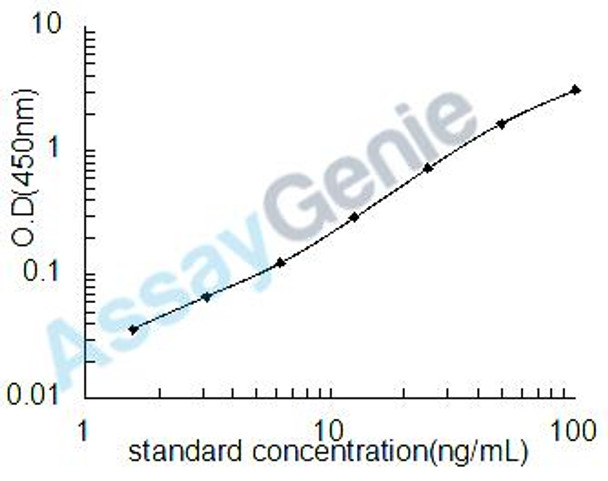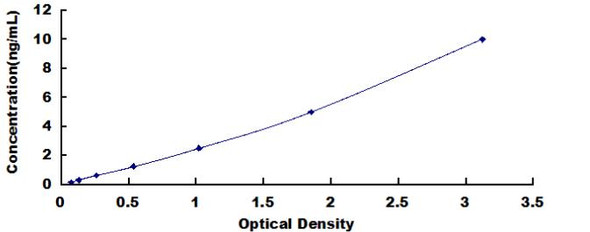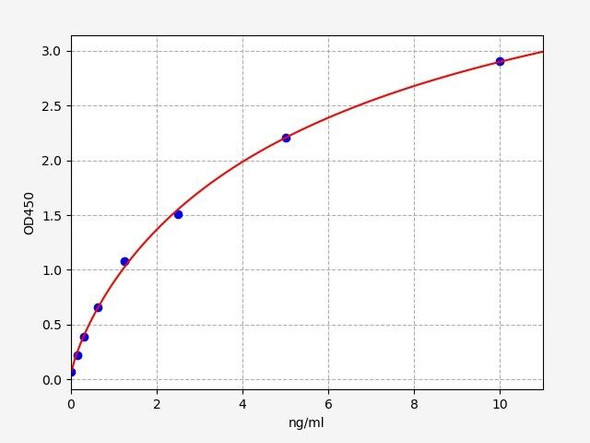Description
Human Cystathionine beta-synthase (CBS) ELISA Kit
The Human Cystathionine Beta Synthase (CBS) ELISA Kit is a powerful tool for accurately measuring levels of CBS in human samples such as serum, plasma, and cell culture supernatants. With its high sensitivity and specificity, this kit provides reliable and reproducible results, making it well-suited for a variety of research applications.CBS is an enzyme that plays a crucial role in the metabolism of sulfur-containing amino acids and in the production of hydrogen sulfide, which has been implicated in various physiological processes and disease states.
Dysregulation of CBS activity has been linked to conditions such as homocystinuria, cardiovascular disease, and neurodegenerative disorders, making it a valuable biomarker for understanding these pathologies and potentially developing therapeutic interventions.With the Human CBS ELISA Kit, researchers can accurately measure CBS levels in human samples, providing valuable insights into its role in health and disease. This kit is essential for any laboratory studying sulfur metabolism, cardiovascular health, or neurodegenerative disorders.
| Product Name: | Human Cystathionine beta-synthase (CBS) ELISA Kit |
| SKU: | HUEB2062 |
| Size: | 96T |
| Target: | Human Cystathionine beta-synthase (CBS) |
| Synonyms: | Beta-thionase, Serine sulfhydrase |
| Assay Type: | Sandwich |
| Detection Method: | ELISA |
| Reactivity: | Human |
| Detection Range: | 1.56-100ng/mL |
| Sensitivity: | 0.79ng/mL |
| Intra CV: | 5.2% | ||||||||||||||||||||
| Inter CV: | 7.6% | ||||||||||||||||||||
| Linearity: |
| ||||||||||||||||||||
| Recovery: |
| ||||||||||||||||||||
| Function: | Hydro-lyase catalyzing the first step of the transsulfuration pathway, where the hydroxyl group of L-serine is displaced by L-homocysteine in a beta-replacement reaction to form L-cystathionine, the precursor of L-cysteine. This catabolic route allows the elimination of L-methionine and the toxic metabolite L-homocysteine (PubMed:23981774, PubMed:20506325, PubMed:23974653). Also involved in the production of hydrogen sulfide, a gasotransmitter with signaling and cytoprotective effects on neurons. |
| Uniprot: | P35520 |
| Sample Type: | Serum, plasma, tissue homogenates, cell culture supernates and other biological fluids |
| Specificity: | Natural and recombinant human Cystathionine beta-synthase |
| Sub Unit: | Homotetramer. |
| Research Area: | Cell Biology |
| Subcellular Location: | Cytoplasm Nucleus |
| Storage: | Please see kit components below for exact storage details |
| Note: | For research use only |
| UniProt Protein Function: | CBS: Only known pyridoxal phosphate-dependent enzyme that contains heme. Important regulator of hydrogen sulfide, especially in the brain, utilizing cysteine instead of serine to catalyze the formation of hydrogen sulfide. Hydrogen sulfide is a gastratransmitter with signaling and cytoprotective effects such as acting as a neuromodulator in the brain to protect neurons against hypoxic injury. Defects in CBS are the cause of cystathionine beta- synthase deficiency (CBSD). CBSD is an enzymatic deficiency resulting in altered sulfur metabolism and homocystinuria. The clinical features of untreated homocystinuria due to CBS deficiency include myopia, ectopia lentis, mental retardation, skeletal anomalies resembling Marfan syndrome, and thromboembolic events. Light skin and hair can also be present. Biochemical features include increased urinary homocystine and methionine. Belongs to the cysteine synthase/cystathionine beta- synthase family. 2 isoforms of the human protein are produced by alternative splicing. |
| UniProt Protein Details: | Protein type:Other Amino Acids Metabolism - selenoamino acid; EC 4.2.1.22; Amino Acid Metabolism - glycine, serine and threonine; Amino Acid Metabolism - cysteine and methionine; Lyase Chromosomal Location of Human Ortholog: 21q22.3 Cellular Component: intracellular membrane-bound organelle; nucleolus; cytosol; nucleus Molecular Function:identical protein binding; protein binding; enzyme binding; protein homodimerization activity; cystathionine beta-synthase activity; ubiquitin protein ligase binding; metal ion binding; heme binding; pyridoxal phosphate binding Biological Process: cysteine biosynthetic process via cystathionine; homocysteine catabolic process; L-serine metabolic process; sulfur amino acid metabolic process; transsulfuration; cysteine biosynthetic process from serine; homocysteine metabolic process; L-serine catabolic process; L-cysteine catabolic process Disease: Homocystinuria Due To Cystathionine Beta-synthase Deficiency |
| NCBI Summary: | The protein encoded by this gene acts as a homotetramer to catalyze the conversion of homocysteine to cystathionine, the first step in the transsulfuration pathway. The encoded protein is allosterically activated by adenosyl-methionine and uses pyridoxal phosphate as a cofactor. Defects in this gene can cause cystathionine beta-synthase deficiency (CBSD), which can lead to homocystinuria. Multiple alternatively spliced transcript variants have been found for this gene. [provided by RefSeq, May 2010] |
| UniProt Code: | P35520 |
| NCBI GenInfo Identifier: | 543959 |
| NCBI Gene ID: | 875 |
| NCBI Accession: | P35520.2 |
| UniProt Secondary Accession: | P35520,Q99425, Q9BWC5, B2R993, D3DSK4, |
| UniProt Related Accession: | P35520 |
| Molecular Weight: | 61,863 Da |
| NCBI Full Name: | Cystathionine beta-synthase |
| NCBI Synonym Full Names: | cystathionine-beta-synthase |
| NCBI Official Symbol: | CBS |
| NCBI Official Synonym Symbols: | HIP4 |
| NCBI Protein Information: | cystathionine beta-synthase; beta-thionase; serine sulfhydrase; methylcysteine synthase |
| UniProt Protein Name: | Cystathionine beta-synthase |
| UniProt Synonym Protein Names: | Beta-thionase; Serine sulfhydrase |
| Protein Family: | Cystathionine beta-synthase |
| UniProt Gene Name: | CBS |
| UniProt Entry Name: | CBS_HUMAN |
| Component | Quantity (96 Assays) | Storage |
| ELISA Microplate (Dismountable) | 8×12 strips | -20°C |
| Lyophilized Standard | 2 | -20°C |
| Sample Diluent | 20ml | -20°C |
| Assay Diluent A | 10mL | -20°C |
| Assay Diluent B | 10mL | -20°C |
| Detection Reagent A | 120µL | -20°C |
| Detection Reagent B | 120µL | -20°C |
| Wash Buffer | 30mL | 4°C |
| Substrate | 10mL | 4°C |
| Stop Solution | 10mL | 4°C |
| Plate Sealer | 5 | - |
Other materials and equipment required:
- Microplate reader with 450 nm wavelength filter
- Multichannel Pipette, Pipette, microcentrifuge tubes and disposable pipette tips
- Incubator
- Deionized or distilled water
- Absorbent paper
- Buffer resevoir
*Note: The below protocol is a sample protocol. Protocols are specific to each batch/lot. For the correct instructions please follow the protocol included in your kit.
Allow all reagents to reach room temperature (Please do not dissolve the reagents at 37°C directly). All the reagents should be mixed thoroughly by gently swirling before pipetting. Avoid foaming. Keep appropriate numbers of strips for 1 experiment and remove extra strips from microtiter plate. Removed strips should be resealed and stored at -20°C until the kits expiry date. Prepare all reagents, working standards and samples as directed in the previous sections. Please predict the concentration before assaying. If values for these are not within the range of the standard curve, users must determine the optimal sample dilutions for their experiments. We recommend running all samples in duplicate.
| Step | |
| 1. | Add Sample: Add 100µL of Standard, Blank, or Sample per well. The blank well is added with Sample diluent. Solutions are added to the bottom of micro ELISA plate well, avoid inside wall touching and foaming as possible. Mix it gently. Cover the plate with sealer we provided. Incubate for 120 minutes at 37°C. |
| 2. | Remove the liquid from each well, don't wash. Add 100µL of Detection Reagent A working solution to each well. Cover with the Plate sealer. Gently tap the plate to ensure thorough mixing. Incubate for 1 hour at 37°C. Note: if Detection Reagent A appears cloudy warm to room temperature until solution is uniform. |
| 3. | Aspirate each well and wash, repeating the process three times. Wash by filling each well with Wash Buffer (approximately 400µL) (a squirt bottle, multi-channel pipette,manifold dispenser or automated washer are needed). Complete removal of liquid at each step is essential. After the last wash, completely remove remaining Wash Buffer by aspirating or decanting. Invert the plate and pat it against thick clean absorbent paper. |
| 4. | Add 100µL of Detection Reagent B working solution to each well. Cover with the Plate sealer. Incubate for 60 minutes at 37°C. |
| 5. | Repeat the wash process for five times as conducted in step 3. |
| 6. | Add 90µL of Substrate Solution to each well. Cover with a new Plate sealer and incubate for 10-20 minutes at 37°C. Protect the plate from light. The reaction time can be shortened or extended according to the actual color change, but this should not exceed more than 30 minutes. When apparent gradient appears in standard wells, user should terminatethe reaction. |
| 7. | Add 50µL of Stop Solution to each well. If color change does not appear uniform, gently tap the plate to ensure thorough mixing. |
| 8. | Determine the optical density (OD value) of each well at once, using a micro-plate reader set to 450 nm. User should open the micro-plate reader in advance, preheat the instrument, and set the testing parameters. |
| 9. | After experiment, store all reagents according to the specified storage temperature respectively until their expiry. |
When carrying out an ELISA assay it is important to prepare your samples in order to achieve the best possible results. Below we have a list of procedures for the preparation of samples for different sample types.
| Sample Type | Protocol |
| Serum | If using serum separator tubes, allow samples to clot for 30 minutes at room temperature. Centrifuge for 10 minutes at 1,000x g. Collect the serum fraction and assay promptly or aliquot and store the samples at -80°C. Avoid multiple freeze-thaw cycles. If serum separator tubes are not being used, allow samples to clot overnight at 2-8°C. Centrifuge for 10 minutes at 1,000x g. Remove serum and assay promptly or aliquot and store the samples at -80°C. Avoid multiple freeze-thaw cycles. |
| Plasma | Collect plasma using EDTA or heparin as an anticoagulant. Centrifuge samples at 4°C for 15 mins at 1000 × g within 30 mins of collection. Collect the plasma fraction and assay promptly or aliquot and store the samples at -80°C. Avoid multiple freeze-thaw cycles. Note: Over haemolysed samples are not suitable for use with this kit. |
| Urine & Cerebrospinal Fluid | Collect the urine (mid-stream) in a sterile container, centrifuge for 20 mins at 2000-3000 rpm. Remove supernatant and assay immediately. If any precipitation is detected, repeat the centrifugation step. A similar protocol can be used for cerebrospinal fluid. |
| Cell culture supernatant | Collect the cell culture media by pipette, followed by centrifugation at 4°C for 20 mins at 1500 rpm. Collect the clear supernatant and assay immediately. |
| Cell lysates | Solubilize cells in lysis buffer and allow to sit on ice for 30 minutes. Centrifuge tubes at 14,000 x g for 5 minutes to remove insoluble material. Aliquot the supernatant into a new tube and discard the remaining whole cell extract. Quantify total protein concentration using a total protein assay. Assay immediately or aliquot and store at ≤ -20 °C. |
| Tissue homogenates | The preparation of tissue homogenates will vary depending upon tissue type. Rinse tissue with 1X PBS to remove excess blood & homogenize in 20ml of 1X PBS (including protease inhibitors) and store overnight at ≤ -20°C. Two freeze-thaw cycles are required to break the cell membranes. To further disrupt the cell membranes you can sonicate the samples. Centrifuge homogenates for 5 mins at 5000xg. Remove the supernatant and assay immediately or aliquot and store at -20°C or -80°C. |
| Tissue lysates | Rinse tissue with PBS, cut into 1-2 mm pieces, and homogenize with a tissue homogenizer in PBS. Add an equal volume of RIPA buffer containing protease inhibitors and lyse tissues at room temperature for 30 minutes with gentle agitation. Centrifuge to remove debris. Quantify total protein concentration using a total protein assay. Assay immediately or aliquot and store at ≤ -20 °C. |
| Breast Milk | Collect milk samples and centrifuge at 10,000 x g for 60 min at 4°C. Aliquot the supernatant and assay. For long term use, store samples at -80°C. Minimize freeze/thaw cycles. |
| ELISA |
| Human CBS ELISA Kit |










